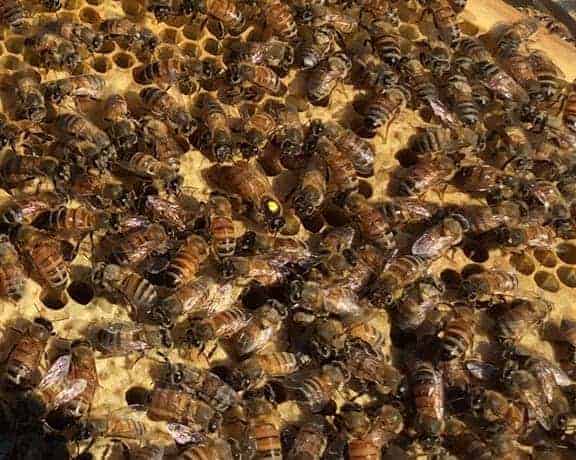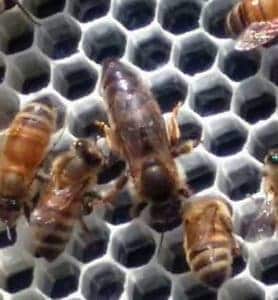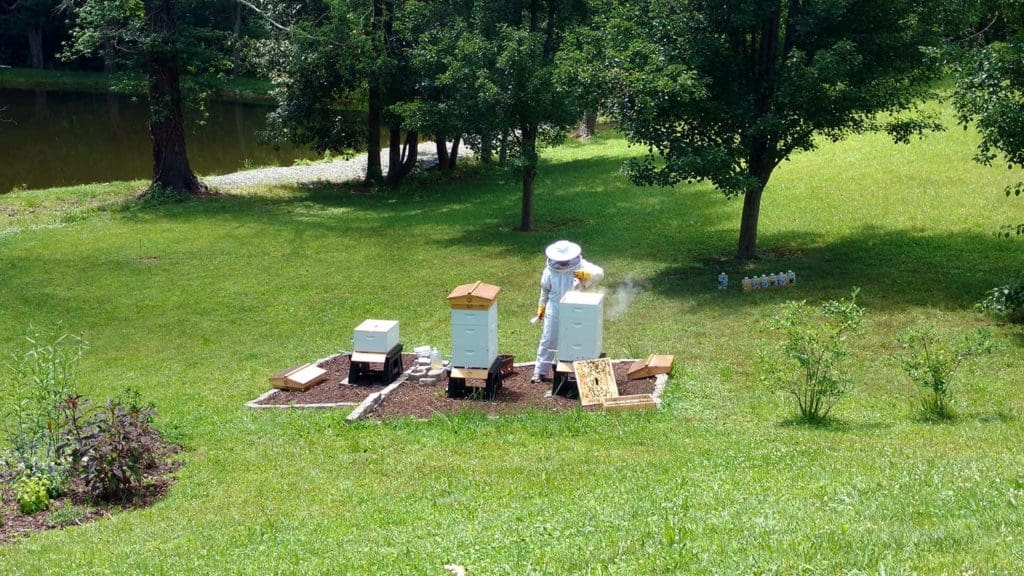I have always loved a great mystery. But, I don’t especially like that in my bee yard! Last week, I had a colony of angry bees remind me that they will take umbrage at my inexperienced fumbling.
This week I returned home from the last of my four weeks of travel and found some mysteries to resolve. So that was my cue to play amateur Sherlock Holmes and solve the case. So the game’s afoot!
Hive Acquitaine
This colony remains a steady and plodding colony, with slow but not spectacular growth. Eggs, larvae and capped brood are present. But, the brood pattern is nowhere near as solid as the brood pattern in my other hives.
I am beginning to have doubts about Eleanor’s viability as a queen. The colony seems happy with her but she should be able to ramp up the production of new workers much quicker than she has to date. The foragers are bringing in pollen but there just isn’t the build-up I would expect at this point.
So far, the colony has drawn some additional comb but not enough to warrant a second deep box. I have started moving the empty frames in between frames of brood to encourage the workers to begin drawing more comb. That may be the biggest impediment to colony expansion. Since both of my other colonies have some empty brood chambers, I may transfer one to this colony to assist with a start.
I refilled the sugar syrup adding Honey B Healthy’s Amino-B Booster filled with amino acids to the mix. Let’s see if that will jumpstart the colony a little bit more.
Hive Olympus
Once upon a time . . . this was my weakest colony but that was before the great Hecate made her appearance as the new Queen. In just a few short weeks, she has made this my strongest hive, and is living up to her Carniolan heritage.
I did not find her this week, which worries me (I love observing this queen!) but her presence is strikingly evident. Her egg-laying is without a doubt a marvel to behold. Hecate is like a production-line! Where I worry about Eleanor’s lack of productivity, Hecate on the other hand makes me worry about the potential for a swarm. I suspect I will have to put on more boxes soon (likely honey supers).
Besides all of the eggs, a rather significant number of larvae are present in all stages of development. But what is most impressive about this queen is the brood pattern in the colony. Frame after frame of newly capped brood fill the boxes. And the brood pattern is nearly solid on these frames with just small margins of pollen and honey on the edges.
The first queen cells have appeared, which will bear more watching given the population explosion happening in this hive.
First Mystery – Why the Increased Aggressive Behavior?
If you remember, this was the colony that got aggressive last week. This week, I worked hard to not crush any bees. But, they were still a bit more aggressive than normal. I would attribute that to a lost queen if there were no eggs. So, my first mystery is what is causing the additional aggression from this hive.
We’ll deal with that shortly. While these bees are a bit more aggressive, they respond well to smoke. I was on the lookout for any stings (only two on the glove this week). The second I saw it I brushed the stinger out of the glove and smoked it. It worked just like it should. And a queen excluder is in my future otherwise Hecate will lay eggs in the honey supers!
Hive Florence
Hive Florence seemed less active when I opened it up for the inspection. This colony is adept at creating queens. That continued this week with four more queen cups with occupants.
Significant amounts of larvae and a fair amount of capped brood were on the frames but no eggs. I searched through a medium box and two deep boxes and found not even a single egg. So that leads me to my second and bigger mystery.
Second Mystery – What Happened to the Queen?
Last week, I couldn’t locate Beatrice and I couldn’t find her again this week. The absence of any eggs bodes ill for the presence of a queen. I worry about working the hives and possibly killing the queen.
I’m sure most of my fellow new beekeepers who are reading this blog agree. So, a question comes to mind that our more experienced friends might be able to answer.
Is it a good idea to locate and catch the queen during an inspection ensuring no possibility of crushing her replacing frames?
This is a question I’ll be asking my bee mentor this week.
Overall, the colony is quite healthy. As I worked through the frames, I found nothing to be concerned about. But, for the lack of Beatrice, things would be great in this hive.
Two Mysteries in the Bee Yard
So to recap, this week presented me with two mysteries in the bee yard:
- Despite an actively laying and productive queen, Hive Acquitaine is suddenly a bit more aggressive. What environmental factor is causing this sudden spike in aggressiveness?
- Hive Florence has a missing queen and no eggs in the frames. What has happened to the queen and in this hive?
The First of my Mysteries – Hive Acquitaine’s Aggressiveness
The mystery concerning Acquitaine’s sudden spike in aggressive behaviors is actually not too difficult to figure out. I’ve been reading a lot about sudden aggressive behaviors by a hive that has previously been docile.
Since I re-queened this hive with the Carniolan queen, it has become quite docile but if you remember back it was quite irritable prior to re-queening. So, I began asking myself, if it is a queen issue, what is causing this sudden alteration in their behavior.
I believe it is a combination of three factors:
- Over the course of the last couple of weeks while I’ve been on the road traveling, I have learned that a neighborhood dog is coming to the edge of the bee yard at nighttime and is barking at the hive. The bees come alive with a very audible buzz when this happens and even come out the front of the hive to investigate. Reading through a number of books on bees and beekeeping, I have learned that disturbances during the night agitate the bees and can make them somewhat more aggressive to their keeper when doing hive inspections.
- From my own personal observation, when you work a hive very fatigued, you tend to be more clumsy and all thumbs. This leads to the inevitable bad moves that only further irritate workers (and especially guard bees!) on higher already. Or, as my beginner beekeeping class told us, “no ninja moves in the hive.” When one worker found herself caught between the keepers glove and a frame, she did what came naturally, stung the jerk! That initial sting generated enough of the alert pheromone to incite the rest of the hive into full onslaught against their interloping, clumsy keeper.
- I have not laundered my bee suit since I started in April. It is very likely that previous stings, as well as all of the stings from last week, have left residue of alarm pheromone around the suit which is alerting the bees and making them more aggressive.
When I thought about things rather logically and dispassionately (that’s a lot easier after the 60 or so workers aren’t angry at you!), it really wasn’t a mystery anymore.
I’m on alert for the neighbor’s dog. I will likely have to have a conversation with the neighbor about an unleashed dog on my property. I am also going to be putting up my bear fence this month which will give the creature a nasty shock if it gets too close. And I am laundering the bee suit tomorrow.
The Second of My Mysteries – A Missing Queen and No Eggs
There are only a couple of possibilities when a queen goes missing:
- During the inspection, the beekeeper inadvertently rolled the queen or even crushed her between two frames
- The queen led a swarm out of the colony
- The queen met an untimely demise due to disease or some other mishap
Let’s deal with these in order and determine what signs are present for each possibility.
During the inspection, the beekeeper inadvertently rolled the queen or even crushed her between two frames.
It is possible to kill your queen while doing a hive inspection. I live in constant fear of this when I’m working the hive as she is such an integral part of the colony.
Reviewing my last three hive inspections as well as my notes leads me to doubt that it was my actions that led to the disappearing queen. I have no doubts that I did not roll the queen or even inadvertently crush her. If I had, I would have expected emergency queen cups to replace her. But all but one of the queen cups has been along the bottoms of the frames. So, I rather quickly ruled out this possibility.
The queen met an untimely demise due to disease or some other mishap.
Although Beatrice was not an overly large queen and was actually on the small side of queens, she was quite healthy and had done a really great job of laying eggs. Her brood pattern was quite normal if not spectacular like Hecate’s brood pattern.
If she had been diseased or otherwise ailing, I don’t believe the bees would have accepted her as the queen as they are sensitive to the pheromones being given off by the queen. I truly believe that if Beatrice had been ailing, she would not have lasted as long as she did in this colony.
So this route seemed like an equally dead end.
The queen led a swarm out of the colony.
This leads me to the last possibility for the missing Beatrice. While I was examining the hive during my inspection, I noticed that things weren’t quite as heavy as they had been just a week before. This colony was my largest and fastest growing colony. It also had lots of capped brood developing as well as eggs and larvae. Just seven days later, there is much less capped brood (I attribute that to emergence of a lot of the capped brood over the past two weeks).
But, thinking back over the past few weeks of inspections, I believe I made a critical mistake.
My hive inspection revealed that I was lighter on honey than I was just a week ago, lighter on capped brood meaning that the queen had stopped laying, and had some early instar larvae which would indicate the queen had departed within the last week having laid her last eggs and then departed the colony.
She was fairly slim for a queen, looking back at the last few pictures I have of her. Also, thinking of overall population, it was pretty common to find the frames packed solid with wall-to-wall bees.
But during this inspection I noticed that the population appears to be about half what it was just a week ago. In fact, Hive Olympus has far outstripped it in population now. Couple those facts with the frequently appearing queen cells, at least two of which had been capped last week.
If you remember, I tore those queen cells out but that was my crucial mistake. I should have performed a split on the colony because reading more closely about the warning signs of an imminent swarm have reminded me that once the queen cup is capped the swarm will happen within days at the most and tearing out the cup will not stop the swarm.
For these reasons, I believe Beatrice swarmed with half my colony and half the honey and has gone on to better locales. I’m now in the process of checking with my local beekeeper’s club to see if a swarm was reported near where I live.
I would not be surprised to find my Beatrice in a nice hive somewhere nearby. So, June with all of its work travel (four trips in five weeks), followed by a nasty head cold, an attacking colony – and now what appears pretty clearly to be a swarm – has been a very eventful month.
So, I left two uncapped queen cups and one capped queen cup in the hive when I closed it up and we will see what emerges by next Saturday. Hopefully a new queen. If not, I’ll re-queen next Saturday. I won’t wait around this time like I did with Hive Olympus.
Coming Next Week
I know I said last week that I was going to talk about my hive inspections and what specifically I looked for in an inspection. In a roundabout way, I did that but there were too many interesting mysteries in the bee yard. Sometimes, well laid plans, need to be set aside.
And that’s what I did this week. I will circle back around to hive inspections and my record-keeping next week. But, this week required a quick sleuthing to solve the mysteries. So, my fellow Watsons, I believe the case is solved. Alas poor Beatrice I knew ye well . . . May the odds be ever in your favor.
Until next time, happy beekeeping! And pray that I get over this cold!




